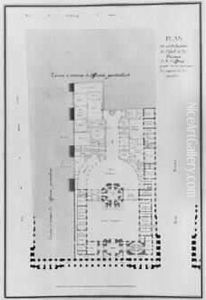Jacques Denis Antoine Paintings
Jacques Denis Antoine was a prominent French architect known for his neoclassical style, which was characteristic of the latter part of the 18th century. Born on August 6, 1733, in Paris, France, he became one of the most influential architects of his time by winning the prestigious Prix de Rome in 1756, a scholarship for art and architecture students to study in Rome, which was a pivotal moment in his career.
After his time in Italy, Antoine returned to France and began his professional career in earnest. He was admitted to the French Academy of Architecture in 1769. His work is particularly noted for its classical rigor, clear forms, and the use of symmetry and proportion typical of the neoclassical movement that sought to revive the principles of ancient Greek and Roman architecture.
One of Antoine's most famous works is the Hôtel des Monnaies (the Paris Mint), which he designed and constructed between 1771 and 1775. This building is considered one of his masterpieces and a quintessential example of neoclassical architecture in France. It showcased his ability to combine functionality with grandeur, resulting in a building that was both a working mint and a statement of architectural beauty.
Another significant project of Antoine's was the design for the Place de la Concorde, although his plans were not fully realized for the famous Parisian square. Nonetheless, his contributions to the architectural landscape of France during the late 18th century were significant. His works reflect the transition in French architecture from the more decorative Rococo style to the restrained and monumental neoclassicism.
Antoine also served as an inspector-general of the École des Beaux-Arts, the premier art school in France, where he had a hand in shaping the education of a new generation of architects. Jacques Denis Antoine passed away on August 24, 1801, in Paris. His legacy lives on through his significant contributions to neoclassical architecture and his influence on the architectural direction of France during a period of aesthetic and political transformation.
